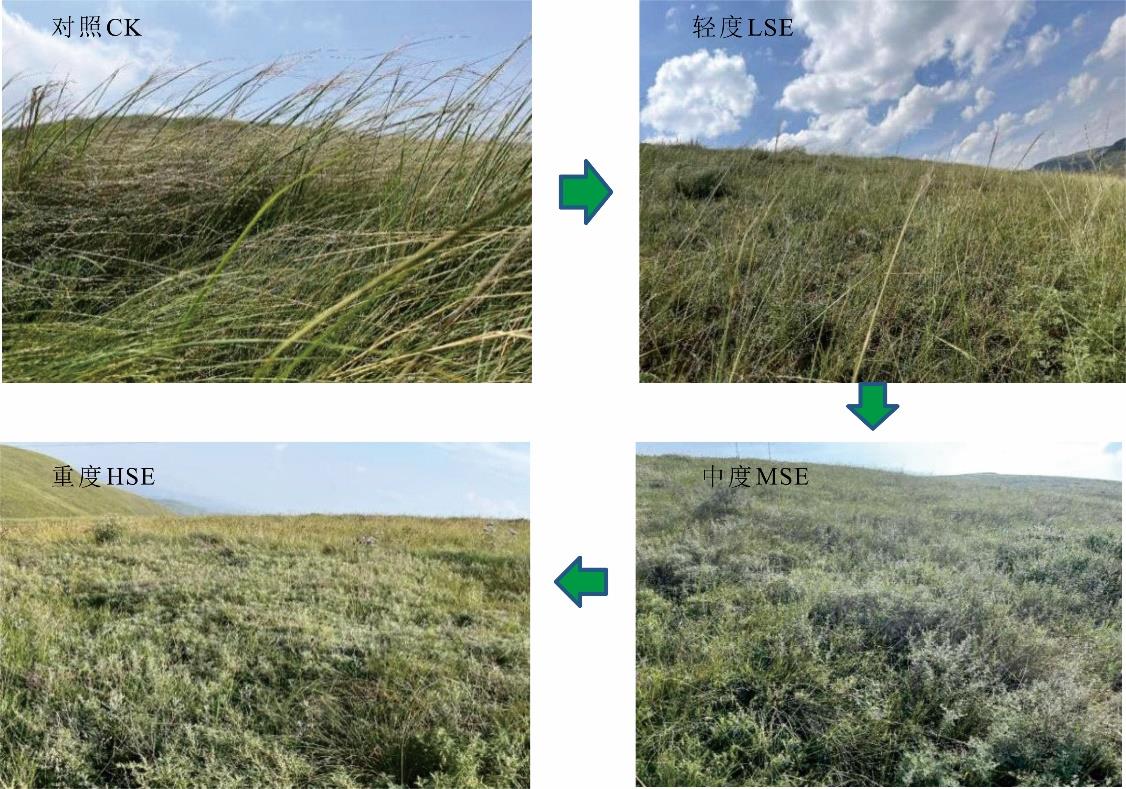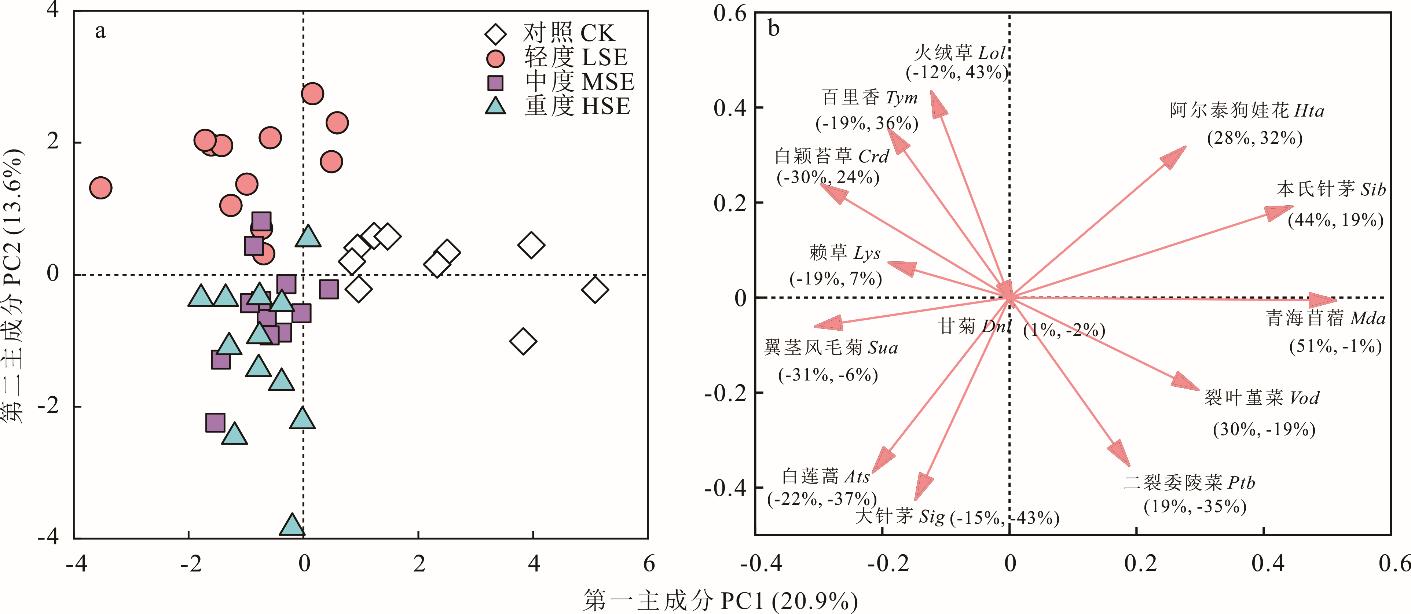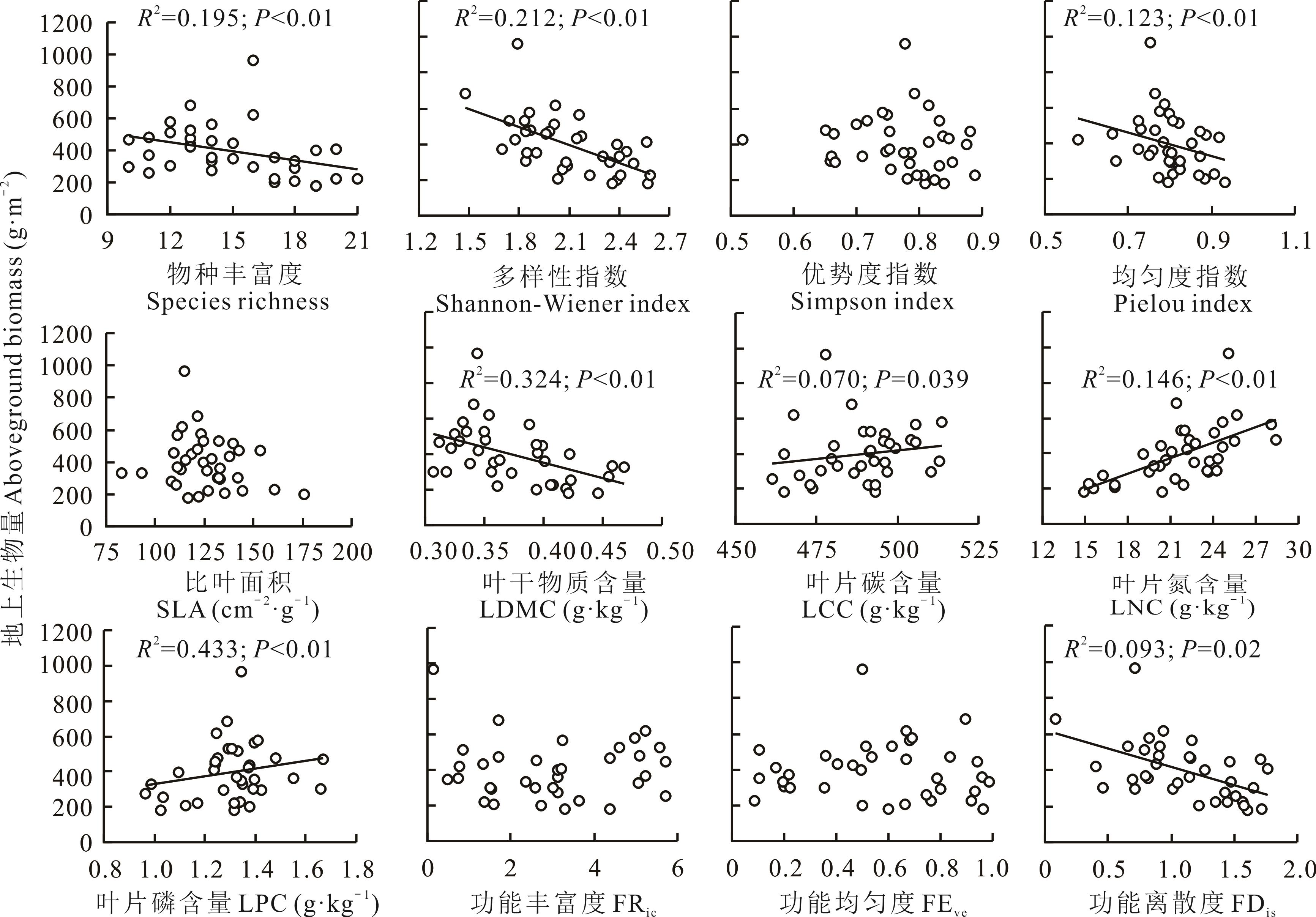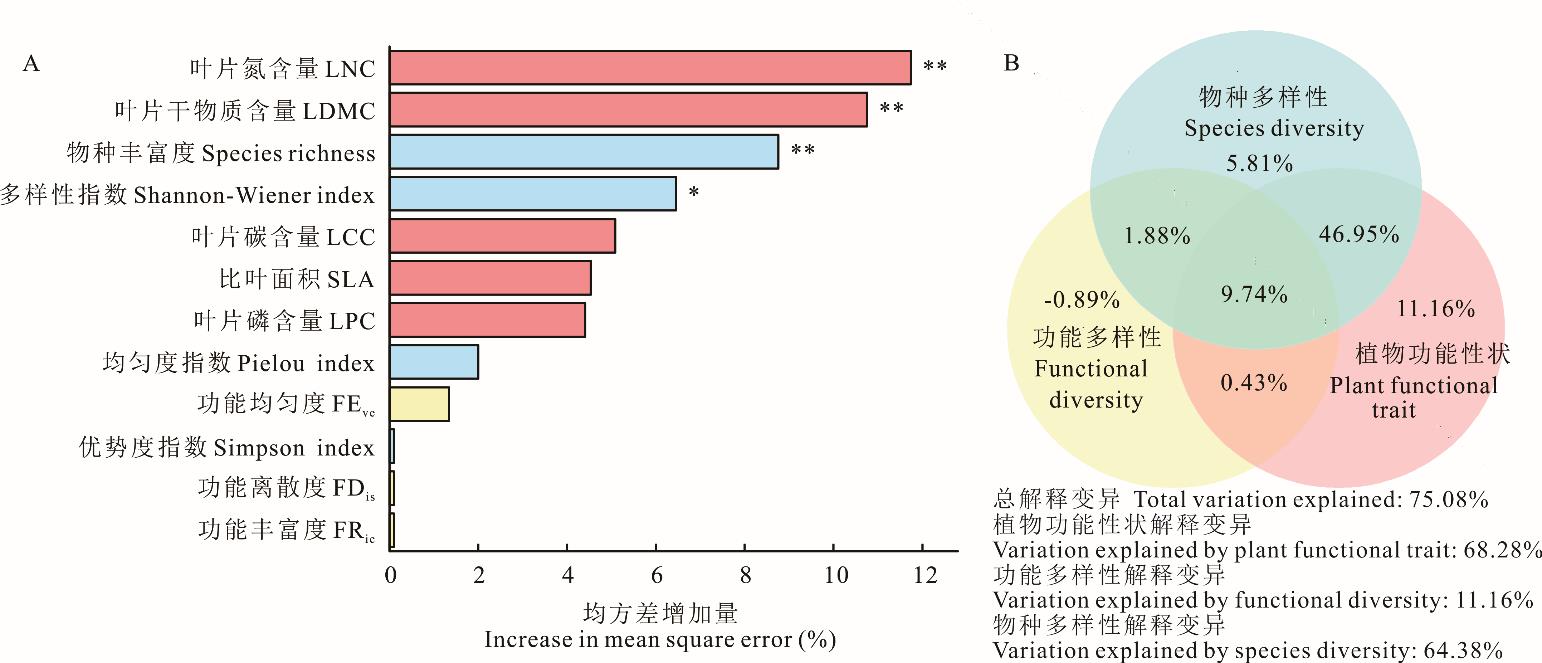

ISSN 1004-5759 CN 62-1105/S


草业学报 ›› 2023, Vol. 32 ›› Issue (5): 27-39.DOI: 10.11686/cyxb2022367
李美慧1( ), 李玉华2, 晏昕辉1, 拓行行1, 杨梦茹1, 王子临1, 李伟3(
), 李玉华2, 晏昕辉1, 拓行行1, 杨梦茹1, 王子临1, 李伟3( )
)
收稿日期:2022-09-15
修回日期:2022-10-17
出版日期:2023-05-20
发布日期:2023-03-20
通讯作者:
李伟
作者简介:E-mail: liwei2013@nwsuaf.edu.cn基金资助:
Mei-hui LI1( ), Yu-hua LI2, Xin-hui YAN1, Hang-hang TUO1, Meng-ru YANG1, Zi-lin WANG1, Wei LI3(
), Yu-hua LI2, Xin-hui YAN1, Hang-hang TUO1, Meng-ru YANG1, Zi-lin WANG1, Wei LI3( )
)
Received:2022-09-15
Revised:2022-10-17
Online:2023-05-20
Published:2023-03-20
Contact:
Wei LI
摘要:
灌木/半灌木扩张能够显著改变原有植被景观及其生态学过程,但目前仍缺乏对半灌木扩张驱动下草地植物多样性、地上生产力变化特征及其二者关系的系统研究。本研究以黄土高原宁夏云雾山典型草原为研究对象,通过选择3个半灌木扩张强度草地(轻度、中度和重度),并以未扩张的天然草地作为对照, 分析物种多样性、群落水平植物功能性状、功能多样性和地上生产力的变化特征及其内在关系。结果表明:1)半灌木扩张驱动下草地群落组成、结构发生了明显改变,半灌木物种白莲蒿已取代了原有的草本植物成为新的草地优势种,且导致物种多样性显著降低;2)与对照相比,半灌木扩张显著降低了群落水平叶干物质含量,但增加了群落水平比叶面积、叶碳、叶氮和叶磷含量;功能丰富度无显著性差异,而功能离散度和功能均匀度在不同扩张强度下差异显著;3)半灌木扩张显著增加了群落地上生产力和凋落物生物量,具体表现为杂草生物量显著增加,豆科生物量显著降低,而禾类草生物量在重度扩张下显著增加;4)半灌木扩张驱动下草地群落地上生产力与物种多样性、群落水平叶干物质含量及功能离散度呈负相关关系,而与群落水平叶碳、叶氮和叶磷含量呈正相关关系。随机森林模型和方差分析结果进一步显示,群落水平功能性状对地上生产力变异解释度为68.28%,其中群落水平叶氮含量和叶干物质含量为最主要的解释因子,物种多样性指数解释度为64.38%,功能多样性指数解释度为11.16%。研究表明半灌木扩张驱动下,物种向快速生长、资源获取型策略转变,且物种生态位分化程度更高;植物功能性状和物种多样性比功能多样性更能解释群落地上生产力的变异。本研究结果可为黄土高原天然草地的稳态转变理论研究和新时期灌丛化草地的适应性和可持续管理提供数据支撑。
李美慧, 李玉华, 晏昕辉, 拓行行, 杨梦茹, 王子临, 李伟. 半灌木扩张驱动的草地植物多样性与地上生产力特征及其关系研究[J]. 草业学报, 2023, 32(5): 27-39.
Mei-hui LI, Yu-hua LI, Xin-hui YAN, Hang-hang TUO, Meng-ru YANG, Zi-lin WANG, Wei LI. Characteristics of plant diversity and aboveground productivity and their relationship driven by subshrub expansion[J]. Acta Prataculturae Sinica, 2023, 32(5): 27-39.

图1 研究区半灌木扩张草地景观LSE: 轻度半灌木扩张Light subshrub expansion; MSE: 中度半灌木扩张Moderate subshrub expansion; HSE: 重度半灌木扩张Heavy subshrub expansion. 下同The same below.
Fig.1 The landscape of subshrub expansion grassland
| 样地Sites | 纬度Latitude (N) | 经度Longitude (E) | 海拔Altitude (m) | 坡度Slope (°) | 白莲蒿重要值Important value of A. sacrorum |
|---|---|---|---|---|---|
| 对照CK | 36°17′06″ | 106°23′30″ | 2011.5 | 1.5 | - |
| 轻度LSE | 36°15′41″ | 106°22′47″ | 2075.7 | 1.6 | 0.04 ±0.01c |
| 中度MSE | 36°15′06″ | 106°23′10″ | 2072.0 | 1.3 | 0.16 ±0.13b |
| 重度HSE | 36°16′15″ | 106°23′25″ | 2107.5 | 1.2 | 0.36 ±0.19a |
表1 各样地的地理特征
Table 1 Geographical features of the sampling sites
| 样地Sites | 纬度Latitude (N) | 经度Longitude (E) | 海拔Altitude (m) | 坡度Slope (°) | 白莲蒿重要值Important value of A. sacrorum |
|---|---|---|---|---|---|
| 对照CK | 36°17′06″ | 106°23′30″ | 2011.5 | 1.5 | - |
| 轻度LSE | 36°15′41″ | 106°22′47″ | 2075.7 | 1.6 | 0.04 ±0.01c |
| 中度MSE | 36°15′06″ | 106°23′10″ | 2072.0 | 1.3 | 0.16 ±0.13b |
| 重度HSE | 36°16′15″ | 106°23′25″ | 2107.5 | 1.2 | 0.36 ±0.19a |
| 物种Species | 缩写Abbreviation | 科Family | 功能群Functional group |
|---|---|---|---|
| 阿尔泰狗娃花H. altaicus | Hta | 菊科Compositae | 杂草Forb |
| 百里香T. mongolicus | Tym | 唇形科 | 杂草Forb |
| 白莲蒿A. sacrorum | Ats | 菊科Compositae | 杂草Forb |
| 白颖苔草Carex duriuscula | Crd | 莎草科Cyperaceae | 禾类草Graminoid |
| 本氏针茅S. bungeana | Sib | 禾本科Gramineae | 禾类草Graminoid |
| 大针茅S. grandis | Sig | 禾本科Gramineae | 禾类草Graminoid |
| 二裂委陵菜Potentilla bifurca | Ptb | 蔷薇科Rosaceae | 杂草Forb |
| 甘菊Dendranthema lavandulifolium | Dnl | 菊科Compositae | 杂草Forb |
| 火绒草Leontopodium leontopodioides | Lol | 菊科Compositae | 杂草Forb |
| 赖草Leymus secalinus | Lys | 禾本科Gramineae | 禾类草Graminoid |
| 裂叶堇菜Viola dissecta | Vod | 堇菜科Violaceae | 杂草Forb |
| 青海苜蓿Medicago archiducis-nicolai | Mda | 豆科Leguminosae | 豆科Legume |
| 翼茎风毛菊Saussurea alata | Sua | 菊科Compositae | 杂草Forb |
表2 测定植物功能性状的物种
Table 2 Species for measuring plant functional traits
| 物种Species | 缩写Abbreviation | 科Family | 功能群Functional group |
|---|---|---|---|
| 阿尔泰狗娃花H. altaicus | Hta | 菊科Compositae | 杂草Forb |
| 百里香T. mongolicus | Tym | 唇形科 | 杂草Forb |
| 白莲蒿A. sacrorum | Ats | 菊科Compositae | 杂草Forb |
| 白颖苔草Carex duriuscula | Crd | 莎草科Cyperaceae | 禾类草Graminoid |
| 本氏针茅S. bungeana | Sib | 禾本科Gramineae | 禾类草Graminoid |
| 大针茅S. grandis | Sig | 禾本科Gramineae | 禾类草Graminoid |
| 二裂委陵菜Potentilla bifurca | Ptb | 蔷薇科Rosaceae | 杂草Forb |
| 甘菊Dendranthema lavandulifolium | Dnl | 菊科Compositae | 杂草Forb |
| 火绒草Leontopodium leontopodioides | Lol | 菊科Compositae | 杂草Forb |
| 赖草Leymus secalinus | Lys | 禾本科Gramineae | 禾类草Graminoid |
| 裂叶堇菜Viola dissecta | Vod | 堇菜科Violaceae | 杂草Forb |
| 青海苜蓿Medicago archiducis-nicolai | Mda | 豆科Leguminosae | 豆科Legume |
| 翼茎风毛菊Saussurea alata | Sua | 菊科Compositae | 杂草Forb |

图2 半灌木扩张草地植物群落PCA分析图2b括号中数值的绝对值分别代表该物种在第一主成分和第二主成分的占比,绝对值越大说明占比越大。The absolute values in parentheses in Fig.2b represent the proportions of the species in the first and second principal components, and a larger absolute value indicates a larger proportion.
Fig.2 PCA of plant community in subshrub expansion grassland

图3 半灌木扩张草地植物群落物种多样性(平均值±标准误)不同小写字母表示不同处理间差异显著(P<0.05)。下同。Different lowercase letters indicate significant differences among different treatments (P<0.05). The same below.
Fig.3 Species diversity of subshrub expansion grassland plant community (mean±SE)

图4 半灌木扩张草地植物群落水平功能性状和功能多样性(平均值±标准误)LDMC: 叶干物质含量Leaf dry matter content; SLA: 比叶面积Specific leaf area; LCC: 叶片碳含量Leaf carbon content; LNC: 叶片氮含量Leaf nitrogen content; LPC: 叶片磷含量Leaf phosphorus content; FRic: 功能丰富度Functional richness; FEve: 功能均匀度Functional evenness; FDis: 功能离散度Functional dispersion. 下同The same below.
Fig.4 Plant community level functional traits and functional diversity of subshrub expansion grassland (mean±SE)

图6 半灌木扩张草地群落地上生物量与物种多样性、群落水平功能形状和功能多样性的关系
Fig.6 Relationship between aboveground biomass and species diversity, community level functional traits and functional diversity of subshrub expansion grassland community

图7 半灌木扩张草地群落地上生产力影响因子的随机森林模型(A)和方差分解(B)结果*: P<0.05; **: P<0.01.
Fig.7 Results of random forest model (A) and variance partition analysis (B) for factors influencing aboveground productivity of subshrub expansion grassland community
| 1 | Van A O W. Causes and consequences of woody plant encroachment into western North American grasslands. Journal of Environmental Management, 2009, 90(10): 2931-2942. |
| 2 | Eldridge D J, Bowker M A, Maestre F T, et al. Impacts of shrub encroachment on ecosystem structure and functioning: Towards a global synthesis. Ecology Letters, 2011, 14(7): 709-722. |
| 3 | Kieft T L, White C S, Loftin S R, et al. Temporal dynamics in soil carbon and nitrogen resources at a grassland-shrubland ecotone. Ecology, 1998, 79(2): 671-683. |
| 4 | Knapp A K, Briggs J M, Collins S L, et al. Shrub encroachment in North American grasslands: Shifts in growth form dominance rapidly alters control of ecosystem carbon inputs. Global Change Biology, 2008, 14(3): 615-623. |
| 5 | Rivest D, Rolo V, López-Díaz L, et al. Shrub encroachment in Mediterranean silvopastoral systems: Retama sphaerocarpa and Cistus ladanifer induce contrasting effects on pasture and Quercus ilex production. Agriculture Ecosystems and Environment, 2011, 141(3): 447-454. |
| 6 | Wang Y X, Chen X J, Lou S N, et al. Woody-plant encroachment in grasslands: A review of mechanisms and aftereffects. Acta Prataculturae Sinica, 2018, 27(5): 219-227. |
| 王迎新, 陈先江, 娄珊宁, 等. 草原灌丛化入侵: 过程、机制和效应. 草业学报, 2018, 27(5): 219-227. | |
| 7 | Brandt J S, Haynes M A, Kuemmerle T, et al. Regime shift on the roof of the world: Alpine meadows converting to shrublands in the southern Himalayas. Biological Conservation, 2013, 158(Complete): 116-127. |
| 8 | Zhou L, Li H, Shen H, et al. Shrub-encroachment induced alterations in input chemistry and soil microbial community affect topsoil organic carbon in an Inner Mongolian grassland. Biogeochemistry, 2017, 136: 311-324. |
| 9 | Zhou L H, Shen H H, Chen L Y, et al. Ecological consequences of shrub encroachment in the grasslands of northern China. Landscape Ecology, 2019, 34(1): 119-130. |
| 10 | Chen L Y, Shen H H, Fang J Y. Shrub-encroached grassland: A new vegetation type. Chinese Journal of Nature, 2014, 36(6): 391-396. |
| 陈蕾伊, 沈海花, 方精云. 灌丛化草原: 一种新的植被景观. 自然杂志, 2014, 36(6): 391-396. | |
| 11 | Gao Q, Liu T. Causes and consequences of shrub encroachment in arid and semiarid region: A disputable issue. Arid Land Geography, 2015, 38(6): 1202-1212. |
| 高琼, 刘婷. 干旱半干旱区草原灌丛化的原因及影响-争议与进展. 干旱区地理, 2015, 38(6): 1202-1212. | |
| 12 | Maestre F T, Bowker M A, Puche M D, et al. Shrub encroachment can reverse desertification in semi-arid Mediterranean grasslands. Ecology Letters, 2010, 12(9): 930-941. |
| 13 | Maestre F T, Eldridge D J, Soliveres S. A multifaceted view on the impacts of shrub encroachment. Applied Vegetation Science, 2016, 19(3): 369-370. |
| 14 | Yan B L, Lv S J, Wang Z W, et al. The advance of shrub encroachment in grassland and its impact on ecosystem. Chinese Journal of Grassland, 2019, 41(2): 95-101. |
| 闫宝龙, 吕世杰, 王忠武, 等. 草地灌丛化成因及其对生态系统的影响研究进展. 中国草地学报, 2019, 41(2): 95-101. | |
| 15 | Zheng Y R, Lai L M, Cai W T, et al. Mechanism of shrub-encroached grasslands restoration in the Ordos Plateau. Journal of Shanxi University (Natural Science Edition), 2022, 45(3): 844-852. |
| 郑元润, 来利明, 蔡文涛, 等. 鄂尔多斯高原灌丛化草地恢复机制解析. 山西大学学报(自然科学版), 2022, 45(3): 844-852. | |
| 16 | Sühs R B, Gieh E L H, Peroni N. Preventing traditional management can cause grassland loss within 30 years in southern Brazil. Scientific Reports, 2020, 10: 783. |
| 17 | Zhang Y, Gao Q, Xu L, et al. Shrubs proliferated within a six-year exclosure in a temperate grassland-Spatiotemporal relationships between vegetation and soil variables. Sciences in Cold and Arid Regions, 2014, 6: 139-149. |
| 18 | O'Connor R C, Taylor J H, Nippert J B. Browsing and fire decreases dominance of a resprouting shrub in woody encroached grassland. Ecology, 2020, 101(2): e02935. |
| 19 | Yu L, Wang H M, Guo T D, et al. Bistable-state of vegetation shift in the desert grassland-shrubland anthropogenic Mosaic area. Acta Ecologica Sinica, 2021, 41(24): 9773-9783. |
| 于露, 王红梅, 郭天斗, 等. 荒漠草原-灌丛镶嵌体的植被稳态转变特征. 生态学报, 2021, 41(24): 9773-9783. | |
| 20 | Hooper D U, Solan M, Symstad A, et al. Species diversity, functional diversity and ecosystem functioning. Oxford: Oxford University Press, 2002: 195-208. |
| 21 | Steudel B, Hallmann C, Lorenz M, et al. Contrasting biodiversity-ecosystem functioning relationships in phylogenetic and functional diversity. New Phytologist, 2016, 212(2): 409-420. |
| 22 | Dı́az S, Cabido M. Vive la différence: Plant functional diversity matters to ecosystem processes. Trends in Ecology and Evolution, 2001, 16(11): 646-655. |
| 23 | Petchey O L, Gaston K J. Functional diversity (FD), species richness and community composition. Ecology Letters, 2002, 5(3): 402-411. |
| 24 | McGill B J, Enquist B J, Weiher E, et al. Rebuilding community ecology from functional traits. Trends in Ecology and Evolution, 2006, 21(4): 178-185. |
| 25 | Butterfield B J, Suding K N. Single-trait functional indices outperform multi-trait indices in linking environmental gradients and ecosystem services in a complex landscape. Journal of Ecology, 2013, 101: 9-17. |
| 26 | Huang X B, Su J F, Li S F, et al. Functional diversity drives ecosystem multifunctionality in a Pinus yunnanensis natural secondary forest. Scientific Reports, 2019, 9(1): 6979. |
| 27 | Grime J P. Benefits of plant diversity to ecosystems: Immediate, filter and founder effects. Journal of Ecology, 1998, 86(6): 902-910. |
| 28 | Tilman D, Lehman C L, Thomson K T. Plant diversity and ecosystem productivity: Theoretical considerations. Proceedings of the National Academy of Sciences of the United States of America, 1997, 94(5): 1857-1861. |
| 29 | Guo Q, Wen Z M, Hossein G, et al. Shift in microbial communities mediated by vegetation-soil characteristics following subshrub encroachment in a semi-arid grassland. Ecological Indicators, 2022,137: 108768. |
| 30 | Chen F R, Cheng J M, Liu W, et al. Effects of different disturbances on soil physical and chemical properties in the typical grassland of Loess Region. Journal of Soil and Water Conservation, 2012, 26(2): 105-110. |
| 陈芙蓉, 程积民, 刘伟, 等. 不同干扰对黄土区典型草原土壤理化性质的影响. 水土保持学报, 2012, 26(2): 105-110. | |
| 31 | Zhu R B, Cheng J M, Liu Y J, et al. Floristic study of spermatophyte in Yunwu Mountain Natural Reserves of China. Acta Agrestia Sinica, 2012, 20(3): 439-443. |
| 朱仁斌, 程积民, 刘永进, 等. 宁夏云雾山自然保护区种子植物区系研究. 草地学报, 2012, 20(3): 439-443. | |
| 32 | Yang X, Yan X H, Li M H, et al. The relationship between species diversity and aboveground productivity at temporal scale in Yunwushan typical grassland of Ningxia. Acta Agrestia Sinica, 2022, 30(2): 259-268. |
| 杨雪, 晏昕辉, 李美慧, 等. 时间尺度上草地物种多样性和地上生产力的关系. 草地学报, 2022, 30(2): 259-268. | |
| 33 | Zhou G, Xia H, Xylab C. Changes in soil water retention and content during shrub encroachment process in Inner Mongolia, northern China. Science Direct, 2021, 206: 105528. |
| 34 | Bai Y F, Wu J, Pan Q, et al. Positive linear relationship between productivity and diversity: Evidence from the Eurasian Steppe. Journal of Applied Ecology, 2007, 44(5): 1023-1034. |
| 35 | Song Y T, Wang P, Zhou D W. Methods of measuring plant community functional diversity. Chinese Journal of Ecology, 2011, 30(9): 2053-2059. |
| 宋彦涛, 王平, 周道玮. 植物群落功能多样性计算方法. 生态学杂志, 2011, 30(9): 2053-2059. | |
| 36 | Thomas A D, Elliott D R, Dougill A J, et al. The influence of trees, shrubs, and grasses on microclimate, soil carbon, nitrogen, and CO2 efflux: Potential implications of shrub encroachment for Kalahari rangelands. Land Degradation and Development, 2018, 29(5): 1306-1316. |
| 37 | Hunter J T. Complexities of shrub encroachment: Are shrubs important for the maintenance of diversity in Themeda-dominated assemblages on coastal headlands in eastern Australia? Journal of Coastal Conservation, 2018, 22(4): 667-677. |
| 38 | Ban J W, Yin Z Y, Zhang Q M, et al. The changes of ecological characteristics of degraded hilly grassland during the transformation from herb dominance to shrub dominance in Heshan, Guangdong. Tropical Geography, 2008(2): 129-133. |
| 班嘉蔚, 殷祚云, 张倩媚, 等. 广东鹤山退化草坡从草本优势向灌木优势演变过程中的生态特征. 热带地理, 2008(2): 129-133. | |
| 39 | Grime J P. Competitive exclusion in herbaceous vegetation. Nature, 1999, 242: 344-347. |
| 40 | Zhang H, Chen S H, Yang S M. The characteristics and ecological geographical distribution of Artemisia sacrorum. Journal of Inner Mongolia Agriculture University (Natural Science Edition), 2001(1): 74-78. |
| 张昊, 陈世璜, 杨尚明. 白莲蒿的特性和生态地理分布的研究. 内蒙古农业大学学报(自然科学版), 2001(1): 74-78. | |
| 41 | Madsen B, Treier U A, Zlinszky A, et al. Detecting shrub encroachment in seminatural grasslands using UAS LiDAR. Ecology and Evolution, 2020, 10(11): 4876-4902. |
| 42 | Garnier E, Cortez J, Billès G, et al. Plant functional markers capture ecosystem properties during secondary succession. Ecology, 2004, 85(9): 2630-2637. |
| 43 | Griffin-Nolan R J, Blumenthal D M, Collins S L, et al. Shifts in plant functional composition following long-term drought in grasslands. Journal of Ecology, 2019, 107(5): 2133-2148. |
| 44 | Muñoz Vallés S, Gallego Fernández J B, Dellafiore C, et al. Effects on soil, microclimate and vegetation of the native-invasive Retama monosperma (L.) in coastal dunes. Plant Ecology, 2011, 212(2): 169-179. |
| 45 | Li W, Zhao J, Epstein H E, et al. Community-level trait responses and intra-specific trait variability play important roles in driving community productivity in an alpine meadow on the Tibetan Plateau. Journal of Plant Ecology, 2017, 10(4): 592-600. |
| 46 | Lopez-Diaz M L, Rolo V R, Benítez R, et al. Shrub encroachment of Iberian dehesas: Implications on total forage productivity. Agroforestry Systems, 2015, 89(4): 587-598. |
| 47 | Peng H Y, Li X Y, Tong S Y. Effects of shrub encroachment on biomass and biodiversity in the typical steppe of Inner Mongolia. Acta Ecologica Sinica, 2013, 33(22): 7221-7229. |
| 彭海英, 李小雁, 童绍玉. 内蒙古典型草原灌丛化对生物量和生物多样性的影响. 生态学报, 2013, 33(22): 7221-7229. | |
| 48 | An Q Q, Qiao W Y, Li W J, et al. Effect of shrub encroachment on grassland community structure and above-ground biomass on the Loess Plateau. Acta Botanica Boreali-Occidentalia Sinica, 2021, 41(4): 664-671. |
| 安琪琪, 乔文英, 李维军, 等. 灌丛化对黄土高原草地植物群落结构和地上生产力的影响. 西北植物学报, 2021, 41(4): 664-671. | |
| 49 | Shan G L, Xu Z, Ning F, et al. Influence of exclosure year on community structure and species diversity on a typical steppe. Acta Prataculturae Sinica, 2008, 17(6): 1-8. |
| 单贵莲, 徐柱, 宁发, 等. 围封年限对典型草原群落结构及物种多样性的影响. 草业学报, 2008, 17(6): 1-8. | |
| 50 | Guo P, Xie L N, Man L, et al. Effects of the expansion of Caragana shrubs on forage yield and plant diversity in desert steppe. Pratacultural Science, 2019, 36(5): 1215-1223. |
| 郭璞, 解李娜, 满良, 等. 荒漠化草原锦鸡儿属灌丛扩增对牧草产量和植物多样性的影响. 草业科学, 2019, 36(5): 1215-1223. | |
| 51 | Ryel R J, Ivans C Y, Peek M S, et al. Functional differences in soil water pools: A new perspective on plant water use in water-limited ecosystems. Springer Berlin Heidelberg, 2008, 69: 397-422. |
| 52 | Noy-Meir I. Desert ecosystems: Environment and producers. Annual Review of Ecology and Systematics, 1973, 4(1): 25-51. |
| 53 | Ogle K, Reynolds J F. Plant responses to precipitation in desert ecosystems: Integrating functional types, pulses, thresholds, and delays. Oecologia, 2004, 141(2): 282-294. |
| 54 | Doherty J M, Callaway J C, Zedler J B. Diversity-function relationships changed in a long-term restoration experiment. Ecological Applications, 2011, 21(6): 2143-2155. |
| 55 | Mittelbach G G, Steiner C F, Scheiner S M, et al. What is the observed relationship between species richness and productivity? Ecology, 2001, 82(9): 2381-2396. |
| 56 | Yang X, Yan X, Guo Q, et al. Effects of different management practices on plant community and soil properties in a restored grassland. Journal of Soil Science and Plant Nutrition, 2022, 22: 3811-3821. |
| 57 | Wright I J, Peich R B, Westoby M, et al. The worldwide leaf economics spectrum. Nature, 2004, 428: 821-827. |
| 58 | He N P, Li Y, Liu C C,et al. Plant trait networks: Improved resolution of the dimensionality of adaptation. Trends in Ecology and Evolution, 2020, 35(10): 908-918. |
| 59 | Pan Q, Zheng H, Wang Z H, et al. Effects of plant functional traits on ecosystem services: A review. Chinese Journal of Plant Ecology, 2021, 45(10): 1140-1153. |
| 60 | Suring L H. Chapter 4: Modeling threats to sagebrush and other shrubland communities in Part Ⅱ: Regional assessment of habitats for species of conservation concern in the Great Basin. Lawrence: Allen Press, 2005: 114-119. |
| 61 | Wagg C, Bender S F, Widmer F, et al. Soil biodiversity and soil community composition determine ecosystem multifunctionality. Proceedings of the National Academy of Sciences of the United States of America, 2014, 111(14): 5266-5270. |
| 62 | Li W, Cheng J M, Yu K L, et al. Plant functional diversity can be independent of species diversity: Observations based on the impact of 4-yrs of nitrogen and phosphorus additions in an alpine meadow. PLoS One, 2015, 10(8): e0136040. |
| [1] | 马婧, 郭方君, 邹枝慧, 孙琳, 陈芳. 腾格里沙漠南缘不同恢复阶段沙质草地植被的季节变化特征[J]. 草业学报, 2023, 32(5): 203-210. |
| [2] | 李江文, 何邦印, 李彩, 回虹燕, 刘博, 张晓曦, 樊慧, 苏文钰. 不同恢复年限草地群落水平植物功能性状及功能多样性分析[J]. 草业学报, 2023, 32(1): 16-25. |
| [3] | 虎雅玲, 哈斯额尔敦, 满良, 杨一, 张萍. 小叶锦鸡儿灌丛地植被对沙源供给的响应[J]. 草业学报, 2023, 32(1): 26-35. |
| [4] | 张丽苗, 谭雪, 董智, 郑杰, 袁中勋, 李昌晓. 喜旱莲子草入侵对三峡库区重庆主城河岸带植物多样性的影响[J]. 草业学报, 2022, 31(9): 13-25. |
| [5] | 李媛媛, 徐婷婷, 艾喆, 周兆娜, 马飞. 锦鸡儿属植物功能性状与根际土壤细菌群落结构的关系[J]. 草业学报, 2022, 31(7): 38-49. |
| [6] | 高瑞, 艾宁, 刘广全, 刘长海, 强方方. 煤矿复垦区不同修复年限林下草本群落特征及其与土壤耦合关系[J]. 草业学报, 2022, 31(6): 61-68. |
| [7] | 卢俊艳, 红梅, 赵巴音那木拉null, 赵乌英嘎, 王文东, 马尚飞, 杨殿林. 贝加尔针茅草原植物群落结构及生物量对长期养分添加的响应[J]. 草业学报, 2022, 31(4): 22-31. |
| [8] | 段媛媛, 张静, 王玲玲, 刘彩凤, 王乙茉, 周俗, 郭正刚. 高原鼠兔对高寒草甸植物物种多样性和功能多样性关系的影响[J]. 草业学报, 2022, 31(11): 25-35. |
| [9] | 罗巧玉, 王彦龙, 杜雷, 刘念, 李丽, 马玉寿. 黄河源区发草适生地植物群落特征及其土壤因子解释[J]. 草业学报, 2021, 30(4): 80-89. |
| [10] | 贺国宝. 祁连山北坡植物群落空间分布格局与多样性研究[J]. 草业学报, 2021, 30(12): 194-201. |
| [11] | 聂莹莹, 陈金强, 辛晓平, 徐丽君, 杨桂霞, 王旭. 呼伦贝尔草甸草原区主要植物种群生态位特征与物种多样性对封育年限响应[J]. 草业学报, 2021, 30(10): 15-25. |
| [12] | 韩福贵, 满多清, 郑庆钟, 赵艳丽, 张裕年, 肖斌, 付贵全, 杜娟. 青土湖典型湿地白刺灌丛沙堆群落物种多样性及土壤养分变化特征研究[J]. 草业学报, 2021, 30(1): 36-45. |
| [13] | 王琇瑜, 黄晓霞, 和克俭, 孙晓能, 吕曾哲舟, 张勇, 朱湄, 曾睿钦. 滇西北高寒草甸植物群落功能性状与土壤理化性质的关系[J]. 草业学报, 2020, 29(8): 6-17. |
| [14] | 车力木格, 刘新平, 何玉惠, 孙姗姗, 王明明. 半干旱沙地草本植物群落特征对短期降水变化的响应[J]. 草业学报, 2020, 29(4): 19-28. |
| [15] | 吴昊, 张辰, 代文魁. 气候变暖和物种多样性交互效应对空心莲子草入侵的影响[J]. 草业学报, 2020, 29(3): 38-48. |
| 阅读次数 | ||||||
|
全文 |
|
|||||
|
摘要 |
|
|||||